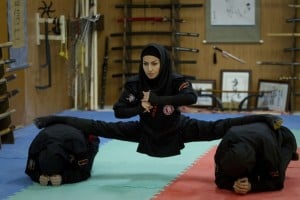This was written by Tasnim and originally appeared at epiphanies.
As Berger has said, photographs are always much more than mechanical records, they bear witness to a unique choice being made. This one is no exception. The woman walking towards the camera hides most of her face and looks apprehensive, almost escaping what is behind her, cut off from the crowd by the bar of a shadow. The angle of the shot imposes as much mystery and menace as possible. Obviously, no photo would be complete without a reminder that this is a Third World country, although ironically, a few pages back the magazine had recommended Libya as a tourist destination precisely for being free of pestering street traders and beggars “so prevalent in many other North African countries.” Elsewhere the reader is reassured that “children in Tripoli are as healthy and happy as anywhere else.”
Of course, this photo and what is conveyed through it necessitates ignoring the fact that women wearing the farashiya are not exactly prevalent in today’s Libya, the caption presenting the emblematic clothing and the attitude it supposedly represents as the reality of all Libyan women, as a statement, a fact. “Libyan woman are demure and prudish.” The picture supplies the proof for an already preconceived essentialist notion of what Libyan women are, and then attaches a tip for tourists: “intense eye contact is not advisable.”
In marked contrast, this picture shows a group of women in a more widespread form of hijab, yet in juxtaposition with the caption “Women power at the Swiss office in Tripoli”, the implication is clear: this is women power as “western imitation”, accessible to usually prudish and demure Libyan women because they are lucky enough to work in a Swiss office.
The same mentality informs a BBC article by Rana Jawad, which claims that “women’s lib is taking off in Libya” and cites various examples yet ends by informing the readers that regrettably, “society’s perceptions of more traditional roles for women prevail” and that “the abiding image in Libya is still of women who rarely mix with men in public and still cover themselves up with a veil”, the double ‘still’ underscoring the severe developmental problems crippling Libyan women in their slow, gradual evolution towards liberation.











